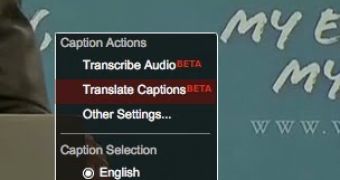YouTube has recently enabled automatic captions for videos, which allow owners to add subtitles to their clips and users to see a written account of what is being said. Google is working on releasing the technology in as many languages as possible, but, for now, it is only available in English. Fortunately, Google already has the technology to translate written words into dozens of languages, which is why it is now introducing Translate Captions, a feature that doesn't really require any explanation.
"We recently mentioned on the official Youtube blog that we were enabling auto-captioning for all Youtube videos. This new technology takes advantage of Google’s speech-to-text algorithms to add captions to videos with spoken English content. Captions have clear benefits for the hearing impaired, but there is another benefit that is worth noting: translation," Andrew Gomez, associate product marketing manager at YouTube, wrote.
"As you know, Google Translate can already translate between any of our 52 supported languages, whether the text is a word, paragraph or website. We [sic] this new advancement in Youtube’s technology we can now add ‘captions’ to that list as well," he added.
The translation technology isn't in wide use right now, in fact you'd be hard pressed to find any videos that get the Translate Captions feature if you didn't know exactly what you were looking for. Of course, even the captions tool has only been available for all users for a couple of weeks, so captions are still a rare sight on YouTube at this point.
YouTube is confident that this will change soon and that captions are enabled for as many videos as possible. Along with auto-captions, the translate feature should also pick up in use. YouTube believes that as many as 150,000 channels will implement both features in the next few months.
Still, YouTube warns that neither technology is perfect and that mistakes do occur. Anyone who has used Google's translation features knows that they get the job done in most cases, but they could use improvements. The number of YouTube captions fail videos that started popping up after the feature was enabled is also proof enough that it could use some work. Putting these two together can only amplify the problems, but YouTube is confident that things will improve in time.

 14 DAY TRIAL //
14 DAY TRIAL //